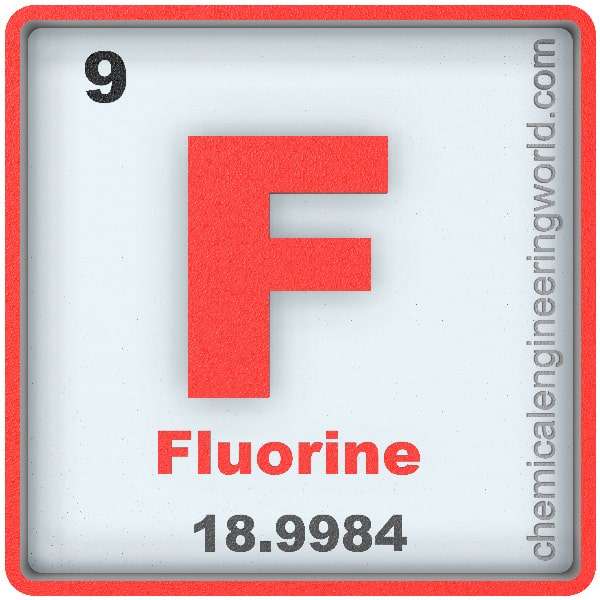Fluorine Element Properties and Information

Fluorine Element Properties and Information:
Fluorine is ninth element on the periodic table. Elements are arranged in the periodic table on the basis of the atomic number. Atomic number is the number of protons in the nucleus of the atom. Fluorine has an atomic number of 9. It is located in the Group 17 and Period 2 of the periodic table of elements. It is denoted by F. The name is derived from the Latin word ‘Fluere’ which means to Flow.
In 1869, George Gore passed an electric current through liquid hydrogen fluoride; he observed that the liberated gas reacted violently with the apparatus. Henri Moissan is credited with the discovery of fluorine because he was the first person who was able to collect the gas. He obtained it by electrolysis of potassium bifluoride dissolved in liquid hydrogen fluoride in 1886.
Fluorine ranks twenty fourth in the universe in terms of abundance compared to other elements. It is thirteenth most abundant element on earth’s crust. Most common fluorine minerals are fluorite, cryolite and fluorspar. Fluorine is widely distributed in other minerals as well.
Physical Properties:
- Fluorine is pale yellow green coloured. It is a halogen.
- The atomic mass of fluorine is 18.998
- The melting point of fluorine is -219.6°C
- The boiling point of fluorine is -188°C
- The density of fluorine is 1.8 in S.I. units at 20°C
- Fluorine-19 is the only isotope of fluorine which occurs naturally in abundance because it is most stable among all other isotopes.
Chemical Properties:
- Fluorine is the most chemically reactive and electronegative among all the elements.
- High electronegativity of fluorine means that the bonds formed with fluorine are very strong. Unreactive materials lie asbestos fibres, glass, powdered steel react quickly under the presence of cold fluorine gas.
- Wood and water combusts spontaneously under the presence of fluorine jet.
- Reaction of fluorine with alkaline earth metals display vigorous activity and reaction of fluorine with alkali metals causes explosion.
Methods of Production:
- Moissan’s method: The most common industrial method used to produce fluorine is by electrolysis of potassium fluoride/ hydrogen fluoride mixture. It is based on Henri Moissan’s work. Hydrogen and fluoride ions are reduced and oxidized at a steel container cathode and carbon block anode to yield hydrogen and fluorine gas.
Relevance in Chemical and Related Industries:
- Alloy industries: Fluoride ions are added to iron alloys to reduce its melting point and viscosity.
- Refrigeration: Freon gases contain fluorine; they are used for refrigeration and air conditioning.
- Polymer industries: Polytetrafluoroethylene also known as Teflon accounts for 60-80% of the total produced fluoro-polymers. It is used in electronic industries because it acts as an excellent dielectric and it is also used in chemical industries where high corrosion resistance is required. Teflon is very popular material for making non-stick cooking utensils.
Relevance in Other Industries:
- Nuclear fuel cycle: Fluorine is used to fluorinate uranium tetrafluoride and form uranium hexafluoride.
- Electrical industries: Fluorine is used to produce inert dielectric sulfur hexafluoride for high voltage transformers and circuit breakers.
- Electronic industries: Tetrafluoromethane is used for plasma etching and nitrogen trifluoride is used for cleaning equipments.
Health Effects on Exposure:
- Toxicity: Fluorine is very toxic to humans; exposure to fluorine gas causes eye and skin irritation, harm to kidneys and nerves at low moderate concentration and death at high concentration.
- Osteoporosis: Although fluoride in toothpaste is necessary to maintain a good dental health but if fluorine is absorbed too frequently it can cause teeth decay and osteoporosis.
Effects on Surroundings:
- Plants and crops: Even moderate increase in concentration of fluorine in the soil can damage leaves of the plants and decline its growth. Too much absorption of fluorine by crops reduced the crop yields.
- Animals: If animals eat plants which contain high fluoride content then the fluoride content inside their bodies will increase. The fluorides primarily accumulates in bones, it causes dental decay, bone degradation and hindrance in development of claws.
- Ozone layer: Freon gases or chlorofluorocarbons attack the ozone layer and cause it to get depleted.
References:
































